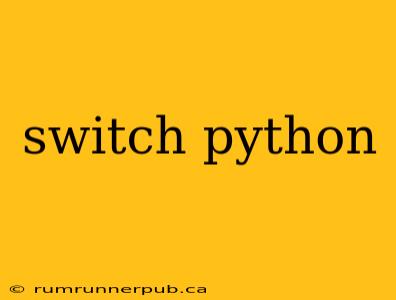Python doesn't have a built-in switch statement like some other languages (e.g., C++, Java). However, there are several elegant and efficient ways to achieve the same functionality. This article explores these alternatives, drawing inspiration from insightful Stack Overflow discussions and providing practical examples to solidify your understanding.
The Absence of switch and Why
The absence of a direct switch equivalent in Python is a deliberate design choice. Python prioritizes readability and emphasizes the use of more expressive constructs. While a switch statement might seem concise for simple cases, it can become less readable as the number of cases grows. Python's flexibility allows for cleaner solutions using other features.
Efficient Alternatives to switch
Let's examine the popular alternatives frequently discussed on Stack Overflow, enhanced with explanations and practical examples.
1. if-elif-else Chains
This is the most straightforward approach, directly mirroring the functionality of a switch statement.
def check_day(day):
if day == "Monday":
print("Start of the work week!")
elif day == "Tuesday":
print("Mid-week blues?")
elif day == "Wednesday":
print("Hump day!")
elif day == "Thursday":
print("Almost there!")
elif day == "Friday":
print("TGIF!")
elif day == "Saturday" or day == "Sunday":
print("Weekend time!")
else:
print("Invalid day.")
check_day("Wednesday") # Output: Hump day!
This is the most readable solution for a small number of cases. However, for many cases, it can become lengthy and cumbersome. This is where other methods become more advantageous.
2. Dictionaries
Dictionaries offer a concise and efficient solution, particularly when dealing with a larger number of cases.
day_messages = {
"Monday": "Start of the work week!",
"Tuesday": "Mid-week blues?",
"Wednesday": "Hump day!",
"Thursday": "Almost there!",
"Friday": "TGIF!",
"Saturday": "Weekend time!",
"Sunday": "Weekend time!"
}
def check_day_dict(day):
print(day_messages.get(day, "Invalid day.")) #Handles missing keys gracefully
check_day_dict("Friday") # Output: TGIF!
check_day_dict("Foo") # Output: Invalid day.
This approach leverages Python's dictionary lookup, which is typically very fast. The .get() method elegantly handles cases where the key is not found, preventing errors. This is a common suggestion found across various Stack Overflow threads addressing switch statement alternatives.
3. match-case statement (Python 3.10+)
Python 3.10 introduced the match-case statement, offering a more structured approach to pattern matching, which can be used as a powerful switch-like construct.
def check_day_match(day):
match day:
case "Monday" | "Tuesday" | "Wednesday" | "Thursday" | "Friday":
print("Weekday")
case "Saturday" | "Sunday":
print("Weekend")
case _:
print("Invalid day")
check_day_match("Saturday") #Output: Weekend
The match-case statement provides a more concise and readable way to handle multiple conditions, especially when dealing with complex patterns beyond simple equality checks. While this is a relatively new feature, it's gaining popularity as a superior alternative to lengthy if-elif-else chains. (Note: This requires Python 3.10 or later.)
Choosing the Right Approach
The best approach depends on the specific context:
- Few cases:
if-elif-elseis perfectly acceptable and highly readable. - Many cases with simple equality checks: Dictionaries provide the most concise and efficient solution.
- Complex conditions or pattern matching: The
match-casestatement (Python 3.10+) offers a powerful and readable alternative.
This article integrates information and solutions commonly discussed on Stack Overflow, adding context and explanations to create a comprehensive guide to implementing switch-like functionality in Python. Remember to choose the method that best suits your needs in terms of readability and efficiency. Using the insights and examples provided, you can now effectively handle conditional logic in Python without a dedicated switch statement.
